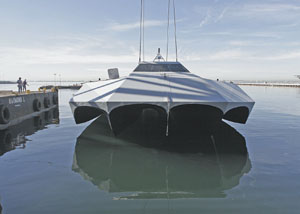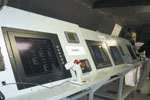Stiletto Cuts a Swath to New Navy Technologies
 |
| The Office of Force Transformation’s Stiletto employs a novel m-hull design to give it high speed and smooth performance even in rough seas. The all-composite hull also weighs a fraction of its equivalent in steel, giving the craft a greater cargo or payload capability. Note the relative size of the two workers at dockside. |
What may be the oddest looking U.S. Navy craft to set sail in years is carrying the hopes of visionaries who aim to transform Navy ships and missions with the aid of advanced technologies. The composite-material craft couples a new hydrodynamic design with a modular network-centric electronic system to leverage the many innovations emerging from the information technology sector.
Known as Stiletto, the craft defies its name by appearance. It is almost 90 feet long, but its beam is more than 40 feet. With a full load, it drafts only 2.5 feet. Only three people are required to operate it, and the diesel-powered craft has a payload area of almost 2,000 square feet.
The Office of Force Transformation built Stiletto in 15 months for $6 million based on some requirements from the U.S. Special Operations Command. Designed by M Ship Company,
Terry J. Pudas, acting director of the Office of Force Transformation, offers that navies must be able to operate in the littorals of the world. In last year’s future fleet architecture study that the office conducted for Congress, it proposed alternative architectures designed to take advantage of capabilities that could be installed on smaller ships. These included alternative construction materials and advanced networking technologies.
Stiletto represents a synergy of three major elements: carbon-fiber construction, a new hull form and a fully networked combat electronics suite.
U.S. Navy officials describe Stiletto as the largest all-composite vessel ever built for the
“This hull illustrates the commercial potential of skipping a generation of building materials and giving the
The channel-hull form has two major attributes. First, it creates hydrodynamic lift from an aerosol of air and water. This reduces water drag considerably and enables it to travel much faster and to absorb shock better than conventional craft.
The second feature of the hull is that it leaves no bow wake. It eats its own wake, and combined with the hydrodynamic lift, this allows it to cushion itself at high speeds. The external hull segments channel the energy of that wake into increased performance.
A smaller prototype of this craft actually increased its speed while heading into the wind during a test. Adding more energy to the underhull layer lifted the craft out of the water, and the decrease in water drag more than offset the increase in the air drag from heading into the wind.
The hull also makes for a smoother trip for the crew. Operators controlling a 50-knot conventional vessel could expect to get slammed into their seats by an extremely rough ride. While Stiletto’s operating crew has special shock mitigating seats, Feldman believes that the craft’s inherent technology will remove the need for those carefully designed seats.
Four Caterpillar diesel engines provide more than 1,650 horsepower each. Cmdr. Gregory E. Glaros, USN, Office of Force Transformation, the initiative lead for Stiletto, explains that diesels were chosen instead of more advanced power plants for their ruggedness, simplicity and cost. Surface-piercing propellers give the craft its ability to travel at more than 50 knots. The Navy commander compares their efficiency to that of racing boat propellers.
The third major element of this new concept in naval vessels is its networked electronics suite. It centralizes all data input from a variety of sources and presents a single situational awareness picture to the craft’s operators. This network provides mission adaptability so that operators do not need to optimize it for a single mission.
The craft currently is configured for special operations missions. It is equipped with a pair of unmanned aerial vehicles (UAVs) as well as a variety of manportable Navy special warfare systems. It also includes an 11-meter rigid hull inflatable boat (RHIB) that can be launched from inside the Stiletto out the stern of the craft.
An experiment in May will showcase how this craft can transform a special operations mission of from five to seven days down to one or two days, relates Quartermaster Chief Scott Keough, special warfare combat crewman who also is a Navy diver and a Navy parachutist.
A key aspect of the craft’s systems is its ability to perform real-time data processing, he notes. That capability comes from its unique network that consolidates all information from systems and sensors inside and outside the craft into a single display suite. The craft’s operators have the ultimate in shipboard situational awareness in front of them as they crew the vessel.
Stiletto’s onboard information network is known as the electronic keel. It monitors the health of the craft in addition to bringing together all of the craft’s principal sensors as well as external data. The user can see all of this information in one setting, explains Kevin S. Poe of Fairmount, West Virginia-based Azimuth Incorporated, builder of the integrated electronic suite. This information includes telemetry, radar, video from external cameras and UAVs, and integrated navigation data such as compass and Global Positioning System (GPS) information. The commander, the navigator and the engineer all can view the same information at their individual stations, which removes the need to move from one station to another.
 |
| The control panels for Stiletto’s electronic keel—shown prior to installation in the control room—give the craft’s three operators full situational awareness of both the ship’s systems and the area battlespace. |
This maritime data bus can drive down integration costs, explains Cmdr. Glaros. By focusing on what can be networked, designers built displays that allow an operator to gain access to data about everything on the craft that has an Internet protocol (IP) address—which is all of its systems—as well as to external sources such as UAVs.
Any element with an IP address can be tasked and its information disseminated and shared. The modular nature enables a plug-and-play architecture down to the component level. All told, the electronic keel can accommodate dozens of sensors, weapons and communications systems on its network.
Cmdr. Glaros adds that the craft also will include a Cluster supercomputer to provide high processing power close to the fight. With new sensors providing volumes of information, operators will need vast amounts of data fused in the network to provide a relevant picture.
Bringing diverse types of data into a ship’s combat information system is not new. The innovation is that Stiletto provides them all in one place. “The ability to accrete individual sensor pieces into a mosaic giving you relevant situational awareness that you can operate by is revolutionary,” Feldman declares. “It enables you to take a small vessel like this—which is going to be limited in the elevation of its antenna and in what its onboard suite of sensors can be—and have the information content that enables you to have an action chain of information from all the distributed pieces that are likely to be in the area.
“The understanding of the environment and what you’re doing that is available for this unit operationally is not based [exclusively] on its own sensor capability. Therefore, a relatively small unit like this in a small vessel in fact has all the benefits of the global situational awareness that comes in the area,” he states.
Another difference between the electronic keel and most of the systems inherent in the services is that the Stiletto’s system is completely adaptable, Feldman continues. One moment an operator might be looking at specific sensor input; the next moment that operator might turn the display into a coverage map that shows the location of other sensors, countermeasures or even people that make up the situational awareness picture.
All the information is at hand, and all that the operator needs is to have an understanding in advance of which information is relevant to which missions might be undertaken. That way, the information architecture can be customized so that data can be parsed and filtered to avoid an information glut, Feldman notes. “There is a decoupling of the combat effect from the size of the unit.”
The electronic keel comprises a 1-gigabit local area network, with four large server racks housing Kontron CP6000 and CP605 blade servers. Tactronics 1500S and 2100S tactical displays provide information to the operators.
As currently configured, the craft’s sensors include a forward looking infrared (FLIR) SeaFLIR II imager, navigation radar and low-light continuous rotate-and-tilt navigation cameras. The vessel is ringed with other cameras for navigation and maneuver.
Its tactical display system, the network’s interface with the craft’s human operators, can accept new target attributes without the need to modify servers or the underlying architecture. It can combine data from diverse situational awareness sources such as Blue Force Tracking systems, identification friend or foe interrogators, electronic warfare systems, Link 11 and Link 16, and Global Command and Control System-M or national level external situational awareness systems.
Despite the craft’s successful early performance, Pudas notes that many questions remain to be answered. Foremost among these is how durable the composite hull will be after extensive service under different weather conditions. Even operational questions such as how the RHIB and Stiletto will operate together must be addressed.
Experts will be testing how Stiletto performs in a variety of potential missions. The goal is to evaluate many new technologies and capabilities introduced into—or by—the craft itself. Toward the end of the testing, these efforts may lead to elemental changes in the craft such as replacing the diesel engines with different power/propulsion technologies or even scaling up the size of the vessel itself to evaluate its design and materials.
“The idea is to facilitate or accelerate learning, which then becomes a competitive advantage,” Pudas states.
Feldman emphasizes that Stiletto is a working craft that takes transformation to the next step. “We are going to learn what the state of the possible is about an embryonic technology paired with an innovative concept, and we will fine-tune that so we will have a prototypical capability early,” he warrants.
“Transformation means what the future is going to look like, where you want to go with the capabilities you want to develop,” he says. “And—for us—it is determining what is a meaningful rung on the ladder to get there.
“This is all real. There are a lot of things that will happen with very bright concepts in
Web Resources
Office of Force Transformation: www.oft.osd.mil
Stiletto: www.oft.osd.mil/initiatives/wolfpac
M Ship Company: www.mshipco.com
Azimuth Incorporated: www.azimuthinc.com
Knight & Carver: www.knightandcarver.com




Comments